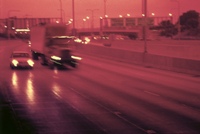The American Association of State Highway and Transportation Officials released a report in Little Rock and in Wichita, Kan., saying freight shipped by tractor-trailers is projected to grow rapidly in the coming couple of decades and much of that travel will be on rural roads…
When most people think about highway work, they think of urban congestion and orange barrels on the road, speakers at an association news conference said. But the 60 million people who live in rural America equal the population of the nation’s largest 100 cities.
"Too often what we found, the needs of rural America … are not understood," Horsley said.
Good roads serve industry and create jobs, just as good schools enhance a community’s vitality, Mississippi highways chief Larry "Butch" Brown said.
"It’s time to provide (rural motorists) with a better system," Brown said.
The South and West are expected to undergo the greatest population growth in the years ahead, and roads and transit systems need to be able to keep up. Brown noted that in Idaho, for instance, major highways are far apart.
"To give you some idea of the scale of these distances, for a farmer to move his grain harvest in Idaho, he would have to cross the width of the entire state of Massachusetts to get from one major highway to the other," Brown said.
In Mississippi, 42,000 farms rely on the state highway network, but at various times during the year, residents must share their roads with hurricane evacuees from Alabama and Florida.
"Most of these evacuees are moving to inland counties, creating traffic backups and long travel times," Brown said. "Narrow two-lane rural roads cannot support the demand of travel if not improved to meet the demand. This is a health and safety issue and must be addressed."
The report notes that 66 U.S. cities with a population of 50,000 or more do not have direct access to interstate highways. The list includes Jefferson City, Mo., which is a state capitol. In Arkansas, Hot Springs and Jonesboro are on the list, although the state has the 12th largest highway system in the U.S., Arkansas highways director Dan Flowers said.


 Federal highway funding is running low. Nothing new there. The Indiana Chamber, and many others, have called for long-term solutions from Washington instead of short-term fixes that simply extend the uncertainty.
Federal highway funding is running low. Nothing new there. The Indiana Chamber, and many others, have called for long-term solutions from Washington instead of short-term fixes that simply extend the uncertainty. According transportation officials, $600 billion is needed to bring America’s rural highways up to speed. The Idaho Statesman
According transportation officials, $600 billion is needed to bring America’s rural highways up to speed. The Idaho Statesman  Debates over funding for public broadcasting are nothing new. The level of deliberations – and funding cuts – has increased dramatically in recent years, threatening the future existence of public television and radio outlets. Some states are currently being hit harder than others with many (including Indiana) suffering. Stateline
Debates over funding for public broadcasting are nothing new. The level of deliberations – and funding cuts – has increased dramatically in recent years, threatening the future existence of public television and radio outlets. Some states are currently being hit harder than others with many (including Indiana) suffering. Stateline  Today’s riddle: When can a good idea also stink? Ag Weekly has the
Today’s riddle: When can a good idea also stink? Ag Weekly has the